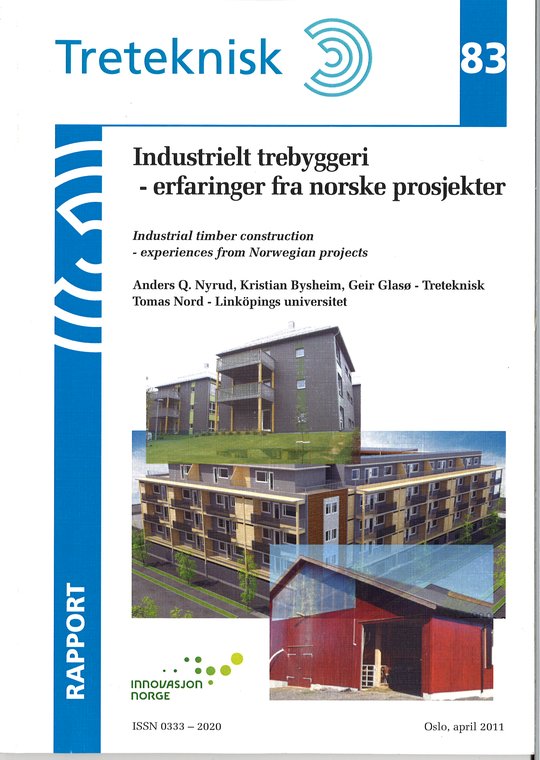83: Industrielt trebyggeri - erfaringer fra norske prosjekter
Forfattere: Anders Q. Nyrud, Kristian Bysheim, Geir Glasø og Tomas Nord (Linköpings universitet)
Rapport 83, 2011
94 s.
200,- (Gratis for medlemmer)
Last ned
Sammendrag
De siste årene har det vært økt interesse for å utvikle konsepter for industrialisering og systematisering av byggeprosessen. Den kraftige etterspørselsveksten etter boliger og næringsbygg fram til 2007, gjorde det nødvendig å effektivisere byggeprosessen (korte ned byggetid, senke byggekostnader, utnytte arbeidskraft mer effektivt). Effektivisering kan realiseres ved å industrialisere produksjons- og byggeprosessen. Industrialisering kan også bidra til jevnere kvalitet på byggeprosjekter (f.eks. mindre variasjon i kvalitet).
Rapporten gir en oversikt over noen utvalgte ferdigstilte trebyggeriprosjekter som har vært gjennomført i Norge i løpet av de siste årene, og hvilke erfaringer man har med industrielt trebyggeri. Tidligere har det ikke blitt samlet inn informasjon om hvilke erfaringer deltakere i industrielle trebyggeriprosjekter har tilegnet seg i løpet av planleggings-, bygge- og bruksfasen. Rapporten er ment å være en katalog over viktige ferdigstilte prosjekter, slik at beslutningstakere i byggeprosessen kan dra nytte av disse. Prosjektenes grad av industrialisering vurderes også, og det gis innspill til videre satsing på industrielt trebyggeri i Norge.
Summary
In recent years there has been an increased interest in developing concepts for industrialization and systematization of the building process. The strong growth in demand for housing and industrial buildings until 2007, necessitated an increase in the efficiency of the building process (shortening the construction period, lowering building costs, utilizing manpower more efficiently). Efficiency improvement can be realized through industrialization of the production process and the building process. Industrialization may also contribute to a more even quality in the building projects (e.g. less variation in quality).
The report provides a summary of some selected timber construction projects completed in Norway during recent years, as well as the experiences made with industrial timber construction. Information regarding the experiences that participants in industrial timber construction projects have acquired during the various phases of the building process (planning, building and operational), have previously not been gathered. The report is intended as a catalogue of important completed projects, in order for decision-makers in the building process to benefit from previous experiences. The degree of industrialization of the projects is also assessed, and suggestions for further efforts in industrial timber construction in Norway are given.
